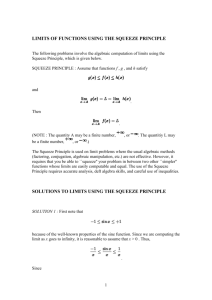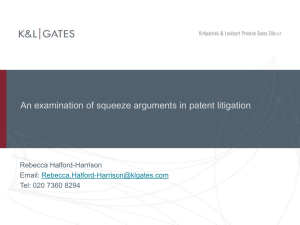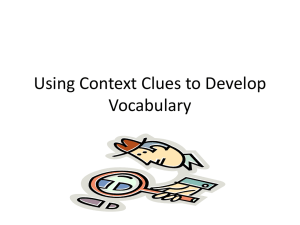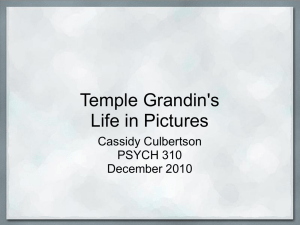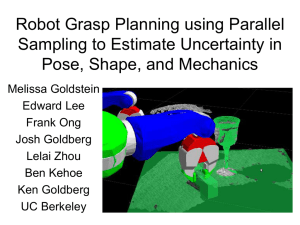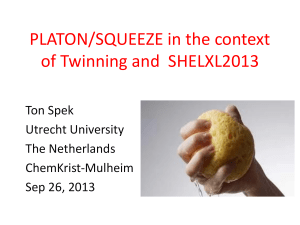Sensorless planning
advertisement
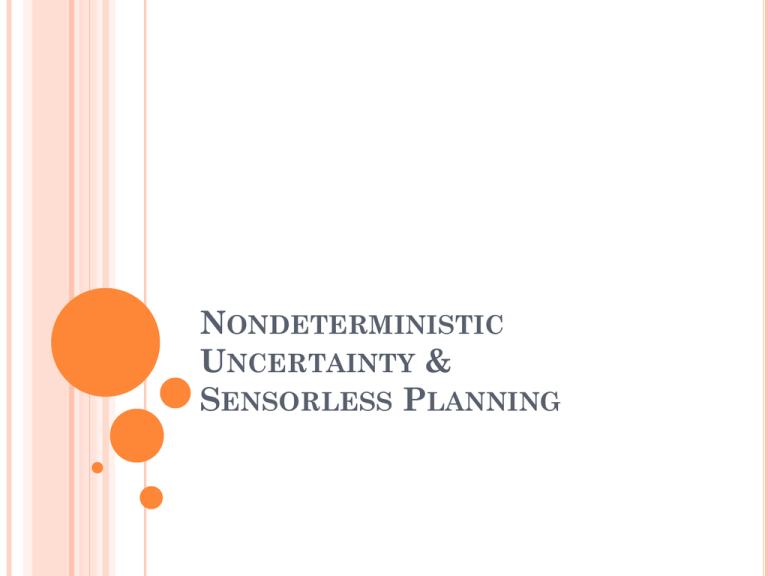
NONDETERMINISTIC
UNCERTAINTY &
SENSORLESS PLANNING
Sensing error
Partial observability
Unpredictable dynamics
Other agents
UNCERTAINTY MODELS
This class: Nondeterministic uncertainty
f(x,u) -> a set of possible successors
Probabilistic uncertainty
P(x’|x,u): a probability distribution over successors
x’, given state x, control u
UNCERTAINTY IN MOTION:
REASONING WITH STATE SETS
x’ = x + e, e [-a,a]
t=0
-a
-2a
a
t=1
2a
Belief State: x(t) [-ta,ta]
t=2
BELIEF STATE DYNAMICS
F(x,u) = { x’ | x’=f(x,u) is a possible successor }
e.g., F(x,u) = [x+u-e , x+u+e]
BELIEF STATE DYNAMICS
F(x,u) = { x’ | x’=f(x,u) is a possible successor }
e.g., F(x,u) = [x+u-e , x+u+e]
Belief prediction: given x(0) X0 and
u(0),…,u(t-1),
Find the set Xt such that any point in Xt is a possible
realization of x(t)
𝑋𝑡 =
𝑥∈𝑋𝑡−1
𝐹(𝑥, 𝑢 𝑡 − 1 )
BELIEF STATE DYNAMICS
F(x,u) = { x’ | x’=f(x,u) is a possible successor }
e.g., F(x,u) = [x+u-e , x+u+e]
Belief prediction: given x(0) X0 and
u(0),…,u(t-1),
Find the set Xt such that any point in Xt is a possible
realization of x(t)
𝑋𝑡 =
𝑥∈𝑋𝑡−1
𝐹(𝑥, 𝑢 𝑡 − 1 )
Boundary-tracking on a grid: level set methods
Applicable to low dimensions (up to ~4)
SENSORLESS PLANNING
MARBLE IN A TILTING MAZE EXAMPLE
Use natural dynamics of compliance to ensure
that uncertainty stays bounded / shrinks
Command
On contact,
certainty is
increased
Uncertain
outcome
A guaranteed
solution
QUESTIONS
Is a solution possible?
How is uncertainty represented / transformed?
Need for actions that reduce uncertainty
GOLDBERG (1998): ORIENTING
POLYGONAL PARTS WITHOUT SENSING
A single parallel jaw gripper can orient parts
that have a polygonal convex hull.
ASSUMPTIONS:
All motions appear in the plane
The gripper has two parallel jaws
The gripper moves orthogonally to its jaws
The object’s convex hull behaves rigidly
The object is presented in isolation
The object is initially between the jaws
Both jaws make contact simultaneously with the
object
Once contact is made, the jaws stay in contact
with the object throughout the grasping motion.
There is no friction between the jaws and the
object
SQUEEZE ACTIONS
Let a squeeze action, α, be the combination of
orienting the gripper at angle α w.r.t. a fixed
world frame, closing the jaws as far as possible,
and then opening the jaws.
To avoid squeezing the object right at its endpoints, a
squeeze action, α, can always be followed by closing
the gripper at angle α + ε, rotating it by -ε, and then
opening it.
ORIENTING A RECTANGLE
A 00 squeeze action, followed by a 450 squeeze
action can orient a rectangular part up to
symmetry.
DIAMETER FUNCTIONS
The diameter function, d:S1->R, describes how
the distance between jaws varies, if they were to
make contact with the object at angle θ.
the diameter of the grasped object at direction θ is
defined to be the maximum distance between two
parallel supporting lines at angle θ.
SQUEEZE FUNCTIONS
The squeeze function, s:S1->S1, is a transfer
function, such that if θ is the initial orientation of
the object w.r.t. the gripper, then s(θ) is the
object’s orientation after the squeeze action is
completed.
Define an s-interval to be [a,b), s.t. a, b are points of
discontinuity in the squeeze function.
Define the s-image of a set, s(Θ), to be the smallest
interval containing the following set: {s(θ)|θ is in Θ}.
ORIENTING A RECTANGLE (CONTINUED)
SQUEEZE FUNCTIONS (CONTINUED)
Θ1 – is an example of an s-interval
s(Θ1) – is the s-image of Θ1
ORIENTING A RECTANGLE (CONTINUED)
Possible Orientations
Before the Squeeze Action
Gripper
Orientatio
n
Possible Orientations
After the Squeeze Action
1.
2.
3.
4.
THE ALGORITHM
Goal:
Given a list of n vertices describing the
convex hull of a polygonal part, find the shortest
sequence of squeeze actions guaranteed to orient the
part up to symmetry.
THE ALGORITHM
Compute the squeeze function;
Find the widest single step in the squeeze
function and set Θ1 equal to the corresponding
s-interval;
While there exists an s-interval Θ s.t.
|s(Θ)|<|Θi|:
1)
2)
3)
•
•
4)
Set Θi+1 equal to the widest such s-interval
Increment i;
Return the list (Θ1 , Θ2 , …, Θi ).
ORIENTING A RECTANGLE (CONTINUED)
The squeeze function plots illustrate steps 2 and 3 of the algorithm:
The output list is: (Θ1 , Θ2)
RECOVERING THE ACTION PLAN
Goal:
Given a list of i s-intervals (Θ1 , Θ2 , …, Θi )
generated by the described algorithm, construct a
plan, ρi ,consisting of i squeeze actions (ai , ai-1 , …,
a1) that collapses all orientations in Θi to the
unique orientation s(Θ1).
RECOVERING THE ACTION PLAN
Observe that for the list (Θ1 , Θ2 , …, Θi ,.. Θn):
|s(Θi+1)|<|Θi|, therefore we could collapse the
interval s(Θi+1) to a point with a single squeeze action
at angle 0 if s(Θi+1) could be aligned with Θi.
This can be done by rotating the gripper by:
s(θi+1) - θi = ai degrees,
where θi and s(θi+1) can be taken as the start of the sinterval Θi and the start of the s-image of s(Θi+1),
respectively.
ORIENTING A RECTANGLE (CONTINUED)
One possible way of aligning s(Θ2) with Θ1 for the rectangular part example is to
rotate the gripper by 450, which results in shifting s(Θ2) by -450 = -π/4.
ALGORITHM ANALYSIS
Correctness:
Completeness:
For any plan ρ, ρ(θ + T) = ρ(θ) + T, where T is the smallest
period in the object’s squeeze function. Thus, the plan ρ
orients the part up to symmetry. It also does it in the
minimal number of steps (see the paper).
Given a starting s-interval, we can either find a larger sinterval that has a smaller s-image, or the starting sinterval is a period of symmetry in the squeeze function.
Therefore, we can generate a sequence of s-intervals (Θ1 ,
Θ2 , …, Θi ) of increasing measure.
Complexity:
Runs in time O(n2log n) and finds plans of length O(n2)
(Note: there are newer derivations of lower complexity)
EXTENSION: PUSH-GRASP ACTIONS
Assuming simultaneous contact is unreliable
Let a push-grasp action, α, be the combination
of orienting the gripper at angle α w.r.t. a fixed
world frame, translating the gripper in direction
α + π/2 for a fixed distance, closing the jaws as
far as possible, and then opening the jaws.
Can derive a push-grasp squeeze function as
before and apply the same algorithm
NONDETERMINISM IN SENSING
Achieve goal for every possible sensor result in
belief state
Move
1
2
Minimizing # of
sensor results
reduces
branching factor
Sense
3
4
Outcomes
INTRUDER FINDING PROBLEM
robot’s
visibility
region
hiding
region
cleared region
robot
1
2
3
4
5
6
A moving intruder is hiding in a 2-D workspace
The robot must “sweep” the workspace to find
the intruder
Both the robot and the intruder are points
DOES A SOLUTION ALWAYS EXIST?
No !
Easy to test:
“Hole” in the workspace
Hard to test:
No “hole” in the workspace
INFORMATION STATE
a = 0 or 1
c = 0 or 1
b = 0 or 1
(x,y)
0 cleared region
1 hidding region
Example of an information state = (x,y,a=1,b=1,c=0)
An initial state is of the form (x,y,1, 1, ..., 1)
A goal state is any state of the form (x,y,0,0, ..., 0)
CRITICAL LINE
b=1
a=0
a=0
b=1
Information state is unchanged
b=0
a=0
Critical line
CRITICALITY-BASED
DISCRETIZATION
A
E
B
C
D
Each of the regions A, B, C, D, and E
consists of “equivalent” positions of the robot,
so it’s sufficient to consider a single position
per region
CRITICALITY-BASED
DISCRETIZATION
(C, 1, 1)
A
(B, 1)
E
B
C D
(D, 1)
CRITICALITY-BASED
DISCRETIZATION
(C, 1, 1)
A
(B, 1)
(D, 1)
E
B
C
D
(C, 1, 0)
(E, 1)
CRITICALITY-BASED
DISCRETIZATION
(C, 1, 1)
A
(B, 1)
(D, 1)
E
B
C D
(C, 1, 0)
(B, 0)
(D, 1)
(E, 1)
CRITICALITY-BASED
DISCRETIZATION
(C, 1, 1)
A
(B, 1)
(D, 1)
E
B
C
D
Discretization chosen explicitly
to get small search trees
(C, 1, 0)
(B, 0)
(D, 1)
(E, 1)
REMARKS
Planners that use nondeterministic uncertainty
models optimize for the worst case
In general, devising good discretizations /
information state representations takes a bit of
ingenuity
NEXT TIME
Probabilistic uncertainty
